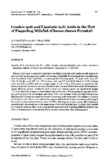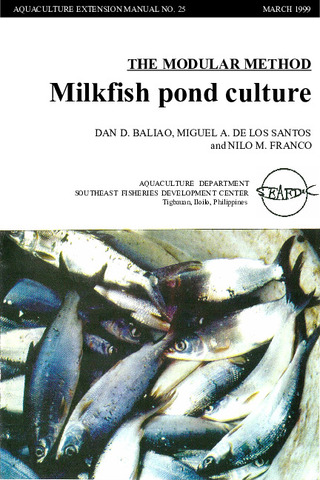Linoleic (ω6) and linolenic (ω3) acids in the diet of fingerling milkfish (Chanos chanos Forsskal)
- Global styles
- MLA
- Vancouver
- Elsevier - Harvard
- APA
- Help

View/
Date
1988Page views
2,915ASFA keyword
AGROVOC keyword
Taxonomic term
Metadata
Show full item record
Share
Abstract
Feeding trials were conducted to determine the effects of linoleic acids on growth, survival, fatty acid composition and liver histology of milkfish. Five isocaloric semi-purified diets were formulated, either lipid-free or containing the following lipids: 7% lauric acid (LA), 6% LA + 1% linoleic, 6% LA + 1% linolenic acid, and 6% LA + 0.5% linoleic + 0.05% linolenic acids, and fed to milkfish with an average weight of 1.55 ± 0.25 g. there were no significant differences in growth or survival between fish fed the lipid-free and the LA diets in the five treatments tested. However, growth of fish fed with linoleic and linolenic acids was significantly higher (P<0.05) than that obtained in fish fed lipid-free and LA diets. The best growth response (233%) was attained with fish fed linolenic acid alone. Fatty acid analyses of the total lipid showed that lipid-free and LA diets increased the levels of monoenoic acids in the fish. The addition of linoleic and linolenic acids, alone or in combination, suppressed the levels of these monoenes and increased the levels of polyunsaturated fatty acids (PUFA). Histological analyses using light microscopy revealed slight abnormalities in the hepatocytes of fish fed lipid-free and LA diets. Both linoleic and linolenic acids are effective for good growth and survival of fingerling milkfish; however, the effect of linolenic acid on the growth of this species is better than that of linoleic acid.
Suggested Citation
Teruel, M. B., & de la Cruz, M. C. (1988). Linoleic (ω6) and linolenic (ω3) acids in the diet of fingerling milkfish (Chanos chanos Forsskal). Aquaculture , 71(4), 347-358. https://doi.org/10.1016/0044-8486(88)90204-9
Type
ArticleISSN
0044-8486Collections
- Journal Articles [1258]
Related items
Showing items related by title, author, creator and subject.
-
Series: Aquaculture extension manual; No. 25
The modular method: Milkfish pond culture
Baliao, Dan D.; de los Santos, Miguel A.; Franco, Nilo M. (Aquaculture Department, Southeast Asian Fisheries Development Center, 1999)The modular method of milkfish culture (Chanos chanos) described in the manual is an improvement over the traditional extensive method. The manual is intended for the use of fish farmers and aquaculturists, extensionists, ... -
Evaluation of organic and inorganic fertilizers in brackishwater milkfish ponds
Bombeo-Tuburan, Isidra; Agbayani, Renato F.; Subosa, Precilla F. (Elsevier, 1989)The study was conducted in twelve 144-m2 ponds to evaluate the effect of different organic and inorganic fertilizers on the growth, survival, gross production, and profitability of marketable milkfish. The ... -
Milkfish breeding and hatchery technology at SEAFDEC/AQD
Unknown author (Aquaculture Department, Southeast Asian Fisheries Development Center, 1999)Describes the techniques already adopted by the private sector: broodstock management, broodstock diet, commercial fry production, live transport, and larval diet. A list of AQD research publications on milkfish is included.





